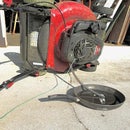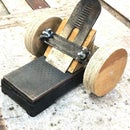Introduction: Make a Center Finder
Make a precision center finder from scrap materials.
Recently egbertfitzwilly posted an Instructable on Finding the Center of a Circle. WirelessMonk posted a link to a machined steel center finder. Rimar mentioned making one. I decided to try making one that would be very precise.
Recently egbertfitzwilly posted an Instructable on Finding the Center of a Circle. WirelessMonk posted a link to a machined steel center finder. Rimar mentioned making one. I decided to try making one that would be very precise.
Step 1: Materials
I had a steel bracket left over from something. I also had a piece of wood with good straight edges. In addition I used a little wood glue and a couple of short screws.
Step 2: Cut the Wood at an Angle
I cut a 45 degree angle across the piece of wood. By cutting it as shown I needed to make only one angle cut for two pieces.
Step 3: The Second Wood Cut
Lay the free piece over the main piece of stock. Mark and cut for the second piece.
Step 4: Flatten the Steel
My scrap piece of steel needed to be flattened. I began by squeezing it with my vise.
Step 5: Pound It Flat
The vise did not do all that was necessary to flatten the steel. Use a ball peen hammer on a flat surface. Pound from both sides to make it as flat as possible.
Step 6: Glue the Wood Pieces
Smear wood glue on the facing edges of the wood pieces.
Step 7: Clamp While Drying
Clamp the wood pieces to a flat surface. A piece of paper from the newspaper or the phone book keeps the glue from sticking to the flat surface. I placed the flat piece of steel under one of the pieces of wood before clamping to lift it so there would be a raised edge at the joint that I could use to align the piece of steel when fastening it to the wood. The edge of the steel will need to bisect exactly the angle formed by the two pieces of wood. The glue line is on the line that bisects the angle. While the glue is not yet hardened scrape away the excess glue with a chisel so the raised edge is clean and sharp.
Step 8: Attach the Steel
When the glue is dry, press the piece of steel against the raised edge. Clamp the steel to the wood so it does not move while you drill and attach the steel to the wood with screws.
Step 9: Use
No allowance has been made for the thickness of a pencil line. I like to use a knife to score a very fine line. Make three or more score lines from different positions around the work piece to see if your center finder is truly accurate. If it is not completely accurate, you will get a small triangle, which also marks the center rather well. I chose steel so it would stand up to the wear imposed on it from the knife I use for marking.
If you want to try another version of a center finder made without laser cutters, etc.; try this link.











